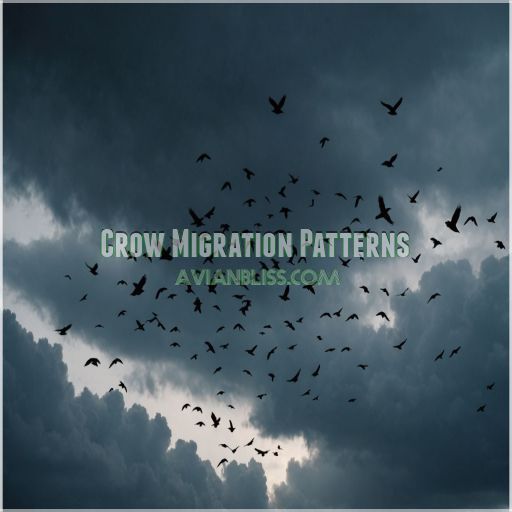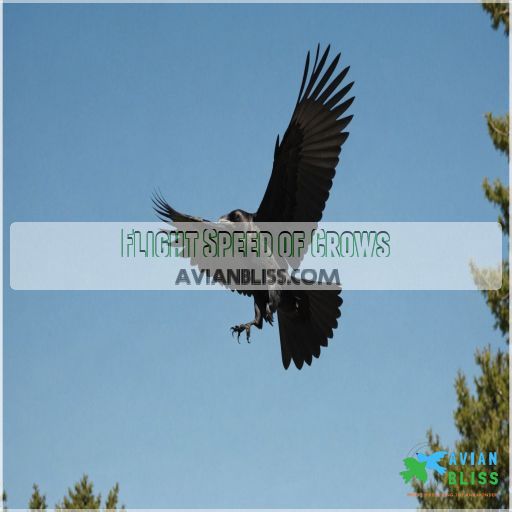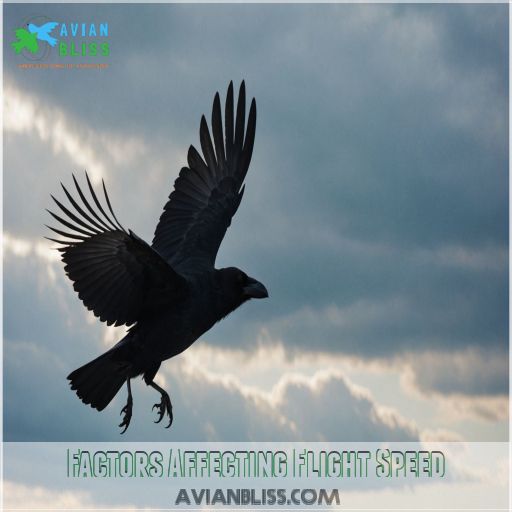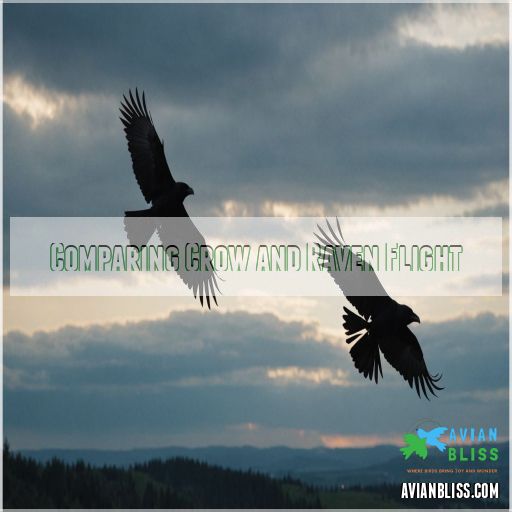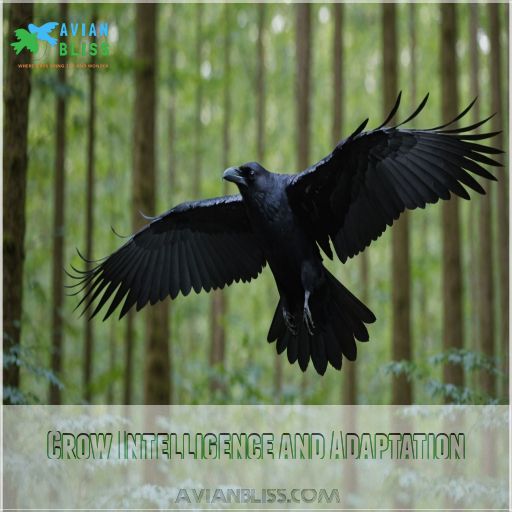This site is supported by our readers. We may earn a commission, at no cost to you, if you purchase through links.
 Ever wondered how fast a crow can fly? These clever birds usually zip around at speeds up to 37 mph. With a good tailwind and some ambition, they can even reach as fast as 60 mph. Picture them darting around like little black arrows, especially when they’re on a mission.
Ever wondered how fast a crow can fly? These clever birds usually zip around at speeds up to 37 mph. With a good tailwind and some ambition, they can even reach as fast as 60 mph. Picture them darting around like little black arrows, especially when they’re on a mission.
Factors like wind, the landscape, and their own health can change things up, but crows know how to make the most of their flight conditions. They’re aerial acrobats, and their ability to navigate and adapt to challenges is impressive.
Keen to learn how these clever birds navigate and adapt to challenges? There’s more to their flight story than just speed.
Table Of Contents
- Key Takeaways
- Crow Migration Patterns
- Flight Speed of Crows
- Factors Affecting Flight Speed
- Daily Flight Range of Crows
- Crow Flight Behavior
- Raven Flight Range in Game of Thrones
- Real-World Raven Flight Range
- Comparing Crow and Raven Flight
- Crow Intelligence and Adaptation
- Crow Flight in Different Environments
- Frequently Asked Questions (FAQs)
- How fast is a crow in mph?
- How far can crows fly in a day?
- What is the flying speed of a crow?
- Which bird can fly the fastest?
- How do crows navigate long distances?
- What are crows fastest recorded speeds?
- How do crows compare to pigeons in speed?
- What environmental factors aid crow navigation?
- Could crows be used for message delivery like pigeons?
- Conclusion
Key Takeaways
- You’ll find crows zooming through the sky at an average speed of about 37 mph, but give them a tailwind and they might just hit 60 mph, making them the little black arrows of the bird world.
- Crows have a special knack for adapting to their flight conditions, using wind and terrain to their advantage. They’re like nature’s acrobats, navigating the skies with grace and skill.
- When traveling in large flocks, also known as a "murder of crows", crows can typically cover between 40 to 60 miles in a day. They’re like daily commuters, always finding their way to the next meal, despite the weather.
- Environmental factors like wind and terrain play a huge role in crow flight. They’re expert navigators, adjusting their path just as you would avoid traffic on your way to work.
Crow Migration Patterns
Ever wonder why only some crows pack up and head south for the winter?
Crows’ migration patterns are a bit like human snowbirds, with some opting for warmer climates while others stay put.
This gives you a glimpse into their unique travel habits and reasons.
Partial Migration Explained
Imagine crows as nature’s snowbirders. Partial migration lets them choose to stay put or fly south, much like crow parents weighing freedom versus comfort.
This behavior shows remarkable site fidelity; they return home like clockwork every year.
Yet, climate change nudges these birds to tweak their routines, echoing how fast can a crow fly into new territories.
Migration Routes and Distances
Crows are partial migrants, taking on detailed migration routes.
You’ll notice a few quirky patterns:
- They often travel short distances, unlike golden eagles or peregrine falcons.
- Crows follow distinct routes, adapting to climate changes and navigation challenges.
- Watching a crow’s journey is similar to watching a bold piece of crow art in motion, full of unpredictability and charm.
Fly-and-Forage Hypothesis
As you observe crow migration patterns, the fly-and-forage hypothesis emerges as a compelling explanation for their daytime travels.
Some bird species, like chickens, have adapted to fly short distances, typically to escape predators or reach new roosts, a behavior that may also influence their foraging patterns a bird’s flight capabilities.
To sustain flight speeds up to 37mph and cover distances of over 186 miles, crows need to fuel up regularly.
They make multiple pit stops to refuel and prepare for the next leg optimizing their energy efficiency and flight routes.
Importance of Roosting Sites
Finding a roosting site isn’t just a feather in your cap; it’s really important for crow survival.
It offers safety in numbers, reduces predator risk, and strengthens community dynamics through shared knowledge.
Habitat conservation plays a key role, as these sites can spur friendly competition for the best spots.
Roost location has a big impact on migration patterns .
Flight Speed of Crows
Ever wondered just how fast a crow can zip through the sky? These feathered speedsters can reach impressive speeds up to 37 mph, making them surprisingly swift despite their chatty personalities.
Measuring Flight Speed
Measuring a crow’s true flight speed is tricky. Factors like wind, terrain, and the bird’s physical condition can all impact the numbers.
But researchers have used clever methods like tracking radar and high-speed cameras to get some reliable data.
For example, one study clocked swifts at speeds over 200 mph! While crows may not reach those dizzying velocities, their flight capabilities are still pretty impressive.
Average Flight Speed
Ever wondered about crow flight speed?
These intelligent fliers average around 37 mph, effortlessly spanning landscapes.
Wind impacts their speed, while rugged terrain can be challenging.
But don’t worry, they expertly navigate these challenges, minimizing energy expenditure.
Like seasoned travelers, crows adjust their flight patterns to optimize every journey, ensuring they reach their destination with minimal fuss, which is a testament to their seasoned travelers.
Top Speeds Recorded
Moving from your average crow flight speed to record-breaking feats, you’ll find crows can zip through the sky at a top speed of 60 mph.
Picture them racing alongside trains, almost keeping up with the wheels on the tracks.
These fastest flyers showcase remarkable abilities, illustrating how crow flight speed can vary with purpose and need.
Comparison to Other Birds
Crow flight isn’t just about speed, although they’ve been clocked at 60 mph.
When you stack them against pigeons or peregrine falcons, crows mightn’t break records, but their flight styles blend intelligence with adaptability.
You could imagine crows saying, "Why rush when you can savor the journey?"
It’s all about balance in the bird world.
Factors Affecting Flight Speed
When you’re curious about how fast a crow can fly, it’s more than just about their wing flaps.
Wind speed, terrain, weather, and even a crow’s own physical condition can make it seem like they’re cruising or just taking it easy in the sky.
They can also be affected by various factors that influence their flight speed, such as the physical condition of the bird itself.
Wind Speed and Direction
Crows may impress you with their nimble flight, but wind speed and direction can really change the game.
You can watch them soar effortlessly with a tailwind, speed reduced by a headwind, or manage a crosswind with skills that might put a pilot to shame.
Wind’s invisible hand plays a significant role:
- Tailwind advantage
- Crosswind challenges
- Headwind effect
Terrain and Elevation
Just as wind speed impacts crow flight, so do terrain and elevation. Picture crows soaring over a vast mountain range. The elevation impact and terrain effects make them adjust their speed and energy.
Ever wondered how you’d feel running uphill? It’s similar for them. They tackle these challenges with ease, thanks to their highly tuned wing dynamics that allow them to respond to updrafts and thermals aerodynamic adaptations in strong winds.
By using wind and updrafts for soaring, crows are able to conserve energy and maintain speed in challenging environments. They tackle these challenges with grace and skill, embodying the freedom of flight.
Weather Conditions
The weather can have a big impact on a crow’s flight speed. Strong winds can slow them down, while tailwinds give them a boost. Heavy rain or snow can make it harder for them to stay airborne.
But crows are adaptable – they’ll adjust their flight patterns to handle whatever Mother Nature throws their way, much like eagles do when facing territorial disputes
.
For example, they’ll:
- Fly lower to avoid strong headwinds
- Seek out thermal updrafts to conserve energy during storms
- Time their migrations to take advantage of favorable weather conditions
Physical Condition of the Bird
Battling wind and weather can sap a crow’s energy, but its physical condition plays a starring role in flight speed.
Consider its age, health, and fitness: a younger, fitter crow will soar like a pro.
Wingspan and body mass also matter—like choosing between a sporty car and an SUV.
Keep your crow trim and sleek for a joyful flight!
Daily Flight Range of Crows
You’re probably wondering just how far a crow can fly in a day.
Well, crows can cover impressive distances, sometimes reaching up to 186 miles daily.
Influenced by factors like wind and the need to find snacks along the way.
Estimated Distances
Imagine crows as daily commuters, winged travelers covering distances up to 40 miles from roosting to feeding sites , often moving through urban environments where they’ve learned to coexist with humans.
Even utilizing their intelligence to scavenge for food in cities like Singapore, where they’ve been known to thrive in areas like Bishan and Hougang Crow Attacks in Urban Areas. It’s impressive for birds balancing between freedom and routine, showcasing their adaptability in the face of changing human behavior.
This crow foraging range highlights their adaptability and intelligence, shrugging at traffic jams below. Comparatively, crows have a modest but efficient daily flight range amidst other avian navigators.
Factors Influencing Range
Moving from estimated distances, let’s consider what shapes a crow’s daily flight range.
Food availability is key; abundant snacks mean more flight. Habitat type also plays a role, as dense forests might slow them down.
Seasonality affects range too, with winter chills and summer sizzles influencing energy levels.
Young, inexperienced crows might struggle more than their seasoned elders.
Historical Modes of Transportation
Crows, much like historical modes of transport, cover notable distances daily.
Think of them as the Pony Express of the sky, swiftly flying about 30-60 miles daily for food.
While not as dramatic as Roman chariots or Mongol cavalry, their consistent travel rivals camel caravans and medieval sailing ships in endurance.
Who knew such small creatures could teach big adventures!
Crow Flight Behavior
When you think about crow flight behavior, picture them migrating during the day and teaming up for nighttime roosting like your friends on a group road trip.
Crows are masters at finding food stops along their route, and they often return to the same spots each year, showing impressive loyalty to their favorite haunts.
Daytime Migration
During the day, crows take to the skies to meet their energy needs.
They’ll soar over neighborhoods, scoping out tasty morsels like:
- Roadkill or discarded food scraps
- Insects and earthworms in freshly tilled fields
- Eggs and nestlings from other birds’ nests
- Shiny objects that catch their curious eyes
This daytime migration helps crows avoid predators and stay connected with their social groups.
Communal Roosting
Imagine flying all day and then seeking a communal roost. It’s like a slumber party with predator defense and social dynamics. Selecting the right roosting site affects safety, warmth, and even disease transmission.
| Aspect | Description | Impact |
|---|---|---|
| Roosting density | Number of crows per area | Influences warmth |
| Predator defense | Safety in numbers | Reduces vulnerability |
| Disease transmission | Close proximity increases risk | Affects health |
Foraging and Refueling
Spotting a crow exploring for dinner reveals clever foraging strategies. As you watch, it’s clear these birds are nature’s backpackers, carrying fuel reserves in their feathers.
Migration timing aligns with abundant food sources, letting them refuel efficiently.
Remember, a well-fed crow is a happy traveler—a fine example of life’s feathered powerhouses in action!
Site Fidelity
When discussing crows, their amazing site fidelity leaps to mind. They often return to the same breeding grounds and wintering sites year after year, like loyal regulars at their favorite café.
This behavior supports:
- habitat conservation efforts
- Intricate migration routes
- Stable local populations
Just imagine a crow as faithful as your well-worn hiking boots.
Raven Flight Range in Game of Thrones
Picture yourself in Westeros, where ravens aren’t just spooky birds but medieval messengers.
Compared to racing pigeons, these winged wonders might seem slow, yet they’re a maester’s best bet for reliable communication across the land, using medieval messengers.
Maester Aemon’s Insight
Crows show impressive flight behavior, but explore Maester Aemon’s insight into raven flight in Westeros.
Ravens excel with intelligence, strength, and self-defense, making them the maesters’ choice over pigeons. Though their speed mightn’t match pigeons, ravens offer reliability and resilience, qualities any message carrier could covet amidst Westeros’s challenges.
Isn’t that the charm of fantasy?
Comparison to Pigeon Flight
From Maester Aemon’s tales, let’s examine how ravens measure up against pigeons.
Pigeons, celebrated in racing circles, can zoom at impressive speeds up to 60 mph, aided by their remarkable flight efficiency and homing instinct.
In contrast, ravens in Westeros seem more about dramatic message delivery, yet don’t underestimate their savvy maneuvering and impressive wingspan comparison.
Practicality of Raven Use
While ravens may not be the speediest flyers, their impressive size, strength, and intelligence make them a practical choice for message delivery in the Game of Thrones world.
Maester Aemon praises their "bolder" and "more clever" nature compared to pigeons.
Their ability to mimic human speech is limited, but their intelligence and problem-solving skills are valuable assets.
Though not as fast, ravens’ advantages could outweigh the need for pure speed in many situations.
Possible Pigeon Use
If ravens seem the practical choice given their strength, you might wonder if pigeons, with their impressive speed, would be a better option in Game of Thrones.
Known for reaching speeds of 50 mph, pigeons combine intelligence and training with the potential for long, efficient flights.
Imagine Westeros’s maesters using pigeons for those urgent messages!
Real-World Raven Flight Range
You might think figuring out how far a raven can fly in a day would be easy, but it’s a bit like trying to guess how far you’ll walk depending on your mood, the weather, and if there’s ice cream at the end.
Researchers haven’t nailed down an exact range yet due to factors like weather and individual differences.
Leaving us waiting for more studies to shed light on this mysterious flight, the exact range of a raven’s flight remains unknown.
Limited Research
Real-world raven flight range isn’t as magical as Game of Thrones, but the mystery remains intriguing.
Crow flight studies highlight gaps in raven flight data, making you scratch your head over bird migration unknowns.
Scientists emphasize wildlife research needs, as our feathered friends keep their aerial exploits mostly under wraps, leaving fans of freedom and power yearning for answers.
Factors Affecting Range
Raven flight range hinges on several factors.
Food and habitat availability steer their journeys, like a GPS guiding a road trip.
Seasonal changes also play a role; who doesn’t love a good seasonal migration?
Human development alters the landscape, affecting prey distribution and sometimes turning urban areas into unexpected avian pit stops .
Individual Variation
As you’ve learned, factors like wind and terrain impact raven flight.
But let’s not forget individual variation. Genetic factors, age, health, experience, and even gender can influence a raven’s journey.
Just like humans, some ravens are more experienced fliers or might’ve a few miles on their wings, making each flight unique and unpredictable.
Further Research Needed
The quest for understanding raven flight ranges is a tantalizing mystery that needs more data.
Questions flutter in your mind: How far does a raven really roam?
- Consider crow wingspan and wingbeats.
- Explore climate’s impact on live distances.
- Examine crow diet differences during travel.
- Investigate crow mating habits seasonal crow breeding behaviors
.
- Recognize variations in terrain and pathways.
Comparing Crow and Raven Flight
Ever wondered how crows stack up against their larger cousins, the ravens?
While both are impressive flyers, crows tend to be faster and more agile, zipping through the skies at speeds up to 37 mph.
But ravens have the edge in long-distance travel, with the ability to cover hundreds of miles in a single day.
Speed and Distance
You’ve explored the raven’s impressive flight range, so let’s chat speed.
Crows, the aerodynamic underdogs, clock around 30-60 mph, balancing speed and grace.
Meanwhile, ravens flaunt a bit more speed, potentially hitting 100-120 km/h with favorable winds.
Whatever the distance covered, both birds effortlessly dominate the skies like nature’s covert couriers, each with its unique flair, showcasing their ability to be impressive.
Flight Behavior
Imagine spotting a crow and a raven in the wild and deciding to track their flight patterns.
Ravens, with their serene soaring, seem to do acrobatics, even somersaults and upside-down feats, while crows prefer practical, steady flaps.
Crow flight strategies are about efficiency, unlike the romantic antics of raven flight physiology and challenges of balancing flair with purpose.
Habitat and Food
Crows and ravens have fascinating habitat preferences and foraging behaviors.
Picture them gracefully foraging across diverse landscapes.
- Crow Diet: Omnivorous, eating both plants and animals with a penchant for tasty roadside snacks.
- Food Sources: From garbage dumps to agricultural fields, nothing escapes their beaks.
- Intelligent Foraging: Clever strategies like dropping shells from heights show their resourcefulness!
Nesting and Population
While crows adapt to urban habitats, ravens prefer solitude in wilder zones.
You’ll find crows up high, hiding nests from predators. Ravens opt for cliff ledges, a bit more exclusive.
Comparing their nesting and population dynamics, a table will help clarify.
| Feature | Crows | Ravens |
|---|---|---|
| Nesting Success | High | Moderate |
| Population Trends | Stable | Increasing |
| Habitat Preference | Urban areas | Remote cliffs |
Clever tactics help them survive amid various threats.
Crow Intelligence and Adaptation
You probably know crows are clever, but their knack for problem-solving and social behavior might just put your neighborhood to shame.
They’re like the adaptable athletes of the bird world, adjusting to climate change and often outsmarting conservation challenges with ease.
Problem-Solving Abilities
Ravens might be powerful flyers, but crows have mastered the art of survival through intelligence. Their problem-solving abilities are astonishing. Crows use tools, solve puzzles, and exhibit adaptability in their problem-solving abilities, often employing complex strategies, like their use of hooks and spears made from sticks and wire to access food tool use and problem-solving
.
- Tool use: Crafting sticks to fish for insects.
- Puzzle-solving: Opening food containers.
- Adaptability: Thriving in urban settings.
- Social learning: Observing and imitating fellow crows.
Social Behavior
You’d be amazed by crows’ social intelligence! These birds form tight-knit family groups, sharing food intel and warning each other of threats.
They even hold "funerals" for fallen flock members (Source).
Crows’ impressive memory and communication skills allow them to thrive in urban areas, outsmarting humans with their cunning foraging strategies and remarkable mimicry abilities crow vocal mimicry
.
Adaptation to Climate Change
From learning clever tricks in urban life to recognizing friend from foe, crows’ social smarts tiptop toe into climate adaptability.
Imagine these brainy creatures adapting to shifting seasons like commuters adjusting to new routes.
Tackling climate change, they’re pioneers in crow migration trends, finding novel crow survival strategies amid nature’s challenges.
Future research will surely uncover more of their adaptability.
Conservation Efforts
Imagine a world where crows, these clever birds, adapt like superheroes to threats like habitat loss and climate change.
Conservationists focus on ethical hunting and roosting site protection to combat declining population trends.
In fact, conservation efforts also involve understanding the importance of preserving natural ecosystems, such as the key roles crows play in pest control and seed dispersal.
By studying their behavior and habitat, we can better protect these intelligent birds.
Let’s work together to protect these avian geniuses, ensuring they continue to thrive and outsmart challenges, making the skies a little brighter for all of us.
Crow Flight in Different Environments
Ever wonder if crows struggle with traffic jams or wind currents?
They’re pretty savvy, adapting their flight speed and patterns to urban sprawl, open countryside, and even pesky mountain peaks.
Showing that not all smart navigators need GPS.
Urban Vs. Rural Environments
Crows flaunt their street smarts both in bustling cityscapes and serene countryside. In urban areas, they feast on fast food scraps while dodging chaotic human interactions, which is no small feat (Source). Rural crows enjoy quieter habitats, following flight paths that take them over vast fields.
- City Noise: Causes flight changes.
- Food Sources: Impact energy.
- Human Presence: Alters behavior.
Coastal Vs. Inland Environments
You’re exploring urban vs. rural crow habits when suddenly, coastal environments swoop in, offering seafood delights like whelks and crabs.
Inland, crows face habitat loss but find solace in favorable roosting patterns.
Imagine their flight paths as highways in the sky—coastal routes rich in food, while inland paths challenge with sparse resources and shifting landscapes, offering a glimpse into the crows’ favorable roosting patterns.
Mountainous Vs. Flat Environments
Crows display fascinating flight strategies, whether they’re soaring over mountains or gliding across flatlands.
In mountainous areas, altitude impacts their flight paths, giving them a leg up with updrafts for soaring, but mountain roosting can be challenging. Flat terrain offers fewer obstacles but requires different adaptations.
- Mountain adaptability: Use updrafts to conserve energy.
- Terrain effects: More varied in mountains.
- Flight paths: Adjust for changing landscapes.
Human Impact on Crow Flight
With habitat loss and climate change, crows adapt impressively. They shift their flight paths due to urbanization’s impact and noise pollution, seeking food availability in cities.
Imagine city crows maneuvering through concrete jungles like urban adventurers while their rural cousins explore quiet, open fields.
Take a peek:
| Impact | Result |
|---|---|
| Urbanization | Food increase |
| Noise | Altered flight |
| Climate | Habitat adjustment |
Enjoy their resilient spirit!
Frequently Asked Questions (FAQs)
How fast is a crow in mph?
Imagine a crow cutting through the sky like a shadow on ice.
It’s clocking speeds of 30 to 60 mph.
These black-winged wonders sometimes hit 70 mph in a dive, showcasing their swift agility.
How far can crows fly in a day?
Crows can typically travel about 40-60 miles in a day, depending on weather conditions and food availability.
These feathery explorers navigate their terrain with skill, often adapting to winds like skilled surfers catching a perfect wave.
What is the flying speed of a crow?
When a crow takes to the skies, it can reach a top speed of around 60 miles per hour, but when diving, it can hit a whopping 70 miles per hour.
Which bird can fly the fastest?
The Peregrine Falcon, a real speedster, holds the title for the fastest bird.
It reaches up to 240 mph during its hunting dive.
That’s not just fast; it’s like nature’s very own rocket in the bird world.
How do crows navigate long distances?
You might wonder how crows find their way across vast distances.
These smart birds use their excellent memory and keen observation skills to navigate.
Often, they learn landmarks and even pick up cues from other animals (Source).
What are crows fastest recorded speeds?
Imagine a crow zooming at 60 mph, almost as fast as traffic on a highway.
These intelligent birds can even dive faster, showing off their surprising speed and agility when they’re really putting pedal to the metal.
How do crows compare to pigeons in speed?
Crows and pigeons both have unique flying speeds.
Crows typically cruise around 30-40 mph, depending on conditions.
On the flip side, racing pigeons can zip up to 60 mph in short bursts, leaving crows in their wake.
What environmental factors aid crow navigation?
Environmental factors like food availability, seasonal changes, and human presence aid crow navigation.
As observed in a study on group formation and dynamics in a zoo, where crows used various parts of the zoo for foraging.
Could crows be used for message delivery like pigeons?
You’d think crows, with their black capes fluttering at Mach speed, could rival pigeons in message delivery.
They’re smart and agile, but pigeons still edge them out in speed and reliability over long distances.
Conclusion
Understanding how fast a crow can fly opens a window into their agile and adaptable nature. Imagine these sleek birds as expert navigators, mastering various environments with impressive speed.
Equipped with keen intelligence, crows adjust their flight to conditions, showcasing their evolutionary success.
Recognizing these fascinating sky acrobats expands your appreciation for nature’s wonders. Next time you see a crow streak across the sky, you’ll know there’s more than meets the eye to their swift journey.
Understanding crows through their flight also highlights their expert navigators.

